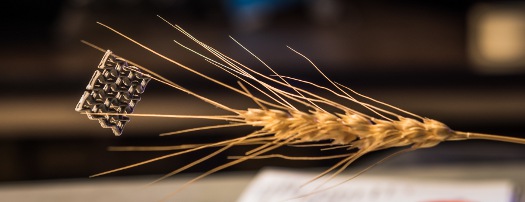 |
| August 15, 2017 | Volume 13 Issue 31 |
Designfax weekly eMagazine
Archives
Partners
Manufacturing Center
Product Spotlight
Modern Applications News
Metalworking Ideas For
Today's Job Shops
Tooling and Production
Strategies for large
metalworking plants
Graphene aerogel is officially world's lightest 3D-printed structure

A square sample of 3D-printed graphene aerogel is so lightweight that a wheat plant's individual, hair-like awn can hold it without bending.[Credit: Kansas State University]
The world's lightest 3D-printed structure is so lightweight that it can be placed on top of a cotton ball or the petals of a flower.
The record-breaking material is 3D-printed graphene aerogel, and it was developed by Dong Lin, Kansas State University assistant professor of industrial and manufacturing systems engineering; Chi Zhou, assistant professor of industrial and systems engineering at University at Buffalo; and Qiangqiang Zhang, an associate professor at Lanzhou University in China.
GUINNESS WORLD RECORDS has named the graphene aerogel as "the least dense 3D-printed structure." The 3D-printed graphene aerogel weighs 0.5 milligrams per cubic centimeter. The researchers developed the material in February 2016 and have received the official recognition from GUINNESS WORLD RECORDS. Their achievement will be featured in the GUINNESS WORLD RECORDS 2018 Edition.
"Graphene is a revolutionary material, and it makes sense that its aerogel form would be just as important," Lin said. "Our 3D-printed graphene aerogel has important properties that give the material many applications for better electronics, batteries, or semiconductors."
Not only is the 3D-printed material groundbreaking, but the way the researchers print the three-dimensional graphene is just as revolutionary.
VIDEO: This time-lapse video shows the 3D-printing process to create a Kansas State University Powercat made of graphene aerogel. GUINNESS WORLD RECORDS has named the graphene aerogel as the world's least dense 3D-printed structure.
Graphene is a single-atom-thick sheet of hexagonally coordinated carbon atoms, which makes it the world's thinnest material and gives it valuable physical and electronic properties.
To 3D print the graphene aerogel, the researchers use a modified inkjet printer that uses two nozzles. They 3D print droplets of a graphene oxide and a water mixture in a freezer on a cold plate that is -20 deg C. This method creates a 3D ice structure of graphene and frozen water, which helps the graphene to maintain its shape, Lin said.
When printing is complete, the researchers place the 3D material in a freeze dryer, which removes the ice by providing high vacuum and low temperature. What's left is a three-dimensional graphene aerogel that maintains its shape at room temperature.
"We didn't plan on setting a record, but it's certainly a nice recognition of our work," Zhou said. "I think this helps show the enormous potential that graphene aerogel has in our daily lives."

Dong Lin, Kansas State University assistant professor of industrial and manufacturing systems engineering, holds a sample made of 3D-printed graphene aerogel, which GUINNESS WORLD RECORDS has named "the least dense 3D-printed structure." [Credit: Kansas State University]
It has been notoriously difficult to create three-dimensional graphene shapes, Lin said, and his collaborative team is the third group in the world to 3D print graphene. Their new printing method is an improvement because it uses fewer ingredients and only requires graphene oxide and frozen water. Additionally, the two nozzles on the modified printer enable the researchers to create complex shapes with less material, which makes it the lightest material in the world.
"With this 3D-printing method, we can control the shape of the graphene aerogel and, ideally, we can control the electric and mechanical properties for the aerogels too," Lin said.
The graphene aerogel has numerous possibilities, from flexible batteries to better semiconductors, and it could even be used to make better insulation in the construction of buildings.
"Aerogel is a special material with a lot of applications, and that's why it is one of the hottest materials throughout the world," Lin said.
VIDEO: Dong Lin, Kansas State University assistant professor of industrial and manufacturing systems engineering, describes the 3D-printed graphene aerogel that he co-developed with researchers at the University at Buffalo and Lanzhou University in China.
Source: Kansas State University
Published August 2017
Rate this article
View our terms of use and privacy policy
